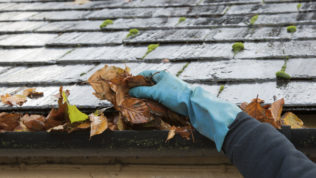Wildfires – unplanned fires in forests, grasslands or other environments – can threaten homes and lives. While wildfires seem to be more destructive in the past several years, the fact is that more urban areas continue to expand into the Wildland-Urban Interface. This trend has not only increased the number of human-caused fires, but it has substantially increased the cost of damage by wildfires. Although not every wildfire can be prevented, you can take steps to make your property more resilient should a wildfire threaten.
Consider these factors to protect your home from being damaged by a wildfire.
CONSTRUCTION
- Choose fire-resistant building materials and construction techniques when building a new home
- Replace combustible building materials, roof and attachments with fire-resistive materials on existing homes
- Use Class A fire-rated roofing products
- Replace or repair existing shingles or tiles if any are missing or loose; this helps to prevent ember intrusion
- Box in or “close” eaves to reduce exposure of ember ignition
- Replace roof and attic vents with ember resistant vents
- Replace combustible decks, fencing and overhangs with fire-resistive materials
- Install dual pane tempered glass windows to reduce the risk of breakage from radiant heat
- Use fire-resistant window and door trim such as brick, fiber-cement, plaster or stucco to prevent ignition from embers that can collect in small nooks or crannies
- Ensure that emergency responders and their equipment can access your property. Driveways should be at least 12 feet wide with a vertical clearance of 15 feet
- Make sure your address number is clearly marked on your house and property
- Provide access to emergency responders if property has automated gates or leave gates open if you have evacuated
HOME MAINTENANCE
- Keep roof and gutters clean and clear of leaves or needles
- Remove dead vegetation from underneath decks or porches
- Replace flammable plastic, wood or fabric outdoor furniture with non-flammable metal or glass
- Store firewood at least 30 feet away from any structure
- Clear at least a 10-foot area around your propane tank or gas grill; this includes removal of all combustibles, including leaves, vegetation, furniture and more
- Remove all combustible furniture, toys or equipment from under porches and decks
- Move propane grills and cylinders, so they are a minimum of 30 feet from any structure
- Store propane cylinders outside; avoid placement in any enclosed area such as garage, basement or shed
- Turn off the main gas supply valve on your propane tank if a wildfire is threatening; turn off gas supply valves for indoor appliances
- Close doors, screens and dampers for propane fireplaces
- Create an emergency action plan for family, pets and livestock BEFORE a wildfire occurs
- Screen or box in areas below patios and decks with wire mesh to prevent debris and combustible materials from accumulating
- Cover exterior attic vents and under-eave soffit vents or screens with metal wire mesh no larger than 1/8 inch to prevent sparks from entering the home if it doesn’t already have ember-resistant venting
LANDSCAPING/VEGETATION MANAGEMENT
- Remove plants on the property that contain resins, oils and waxes. Replace with fire-resistive landscaping
- Replace combustible mulches with crushed stone or gravel up to 5 feet around the home
- Trim tree limbs, shrubs and branches that overhang the roof or touch the house. All vegetation should be at least 10 feet from the house
- Remove flammable and dead vegetation on all sides of the property up to 30 feet
- Maintain lawn by watering and mowing regularly; if any area is dry or brown, trim it down to reduce risk of ignition
- Dispose of lawn cuttings and tree debris
- Prune trees 6 to 10 feet from the ground
- Cut back conifer trees to allow for at least 30 feet between crowns
- Create “fuel breaks” such as gravel walkways or beds or stone retaining walls
- Create 100 feet of defensible space. Follow fire-wise recommendations for Home Ignition Zones: firewise.org
- Immediate Zone: 0-5 feet
- Intermediate Zone 5-30 feet
- Extended Zone 30-100 feet
This loss control information is advisory only. The author assumes no responsibility for management or control of loss control activities. Not all exposures are identified in this article. Contact Landmark Risk Management & Insurance for coverage advice and policy service.

